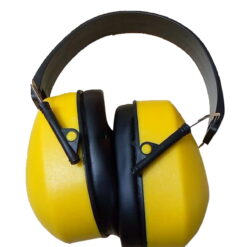Express Deliveries countrywide.
ear muffs (ear protection)

This ear muffs are a popular choice for hearing protection, as they provide a comfortable and convenient solution to reduce noise exposure. When selecting ear muffs, consider the NRR, comfort, adjustability, and specific requirements of the environment to ensure adequate hearing protection for the intended use.
Quantity:
Continue Shopping
Category: Ear muffs
Description
Ear muffs, also known as earmuffs or ear defenders, are protective devices worn over the ears to reduce the intensity of noise and protect the ears from excessive or damaging sound levels. They consist of two ear cups connected by a headband or strap. Here are some key features and considerations of ear muffs:
Noise Reduction Rating (NRR): Ear muffs are designed to attenuate or reduce the intensity of sound reaching the ears. The level of noise reduction is indicated by the Noise Reduction Rating (NRR), which is measured in decibels (dB). A higher NRR indicates greater noise reduction.
Ear Cup Design: Ear muffs have two ear cups that enclose the ears and create a seal to block out sound. The cups are typically made of durable materials such as plastic or metal and are cushioned with foam or other soft materials to provide comfort and a snug fit.
Headband or Strap: Ear muffs are secured to the head using a headband or strap. The headband is adjustable to fit different head sizes and can often be adjusted for a comfortable and secure fit. Some models feature a padded or cushioned headband for enhanced comfort during extended wear.
Noise Isolation: Ear muffs work by creating a physical barrier between the ears and the surrounding environment. The ear cups form a seal over the ears, preventing sound waves from reaching the ear canal. This isolation helps to reduce both high-frequency and low-frequency noise.
Versatility: Ear muffs are used in various settings where noise reduction is necessary, such as industrial workplaces, construction sites, airports, shooting ranges, concerts, and noisy environments. They can provide protection against both continuous and intermittent loud sounds.
Communication Features: Some ear muffs are designed with built-in communication features, such as microphones and speakers, that allow wearers to communicate with others without removing the ear muffs. This feature is particularly useful in environments where hearing protection is necessary but communication is essential.
Compliance and Certification: Ear muffs should comply with relevant safety standards and regulations specific to the industry or region. Certification marks and labeling on the ear muffs indicate compliance with these standards, such as those set by organizations like the Occupational Safety and Health Administration (OSHA) or the European Union’s EN standards.
Care and Maintenance: Ear muffs should be maintained and cleaned regularly according to the manufacturer’s instructions. Proper care helps ensure the longevity and effectiveness of the ear muffs in providing noise protection.
Ear muffs are a popular choice for hearing protection, as they provide a comfortable and convenient solution to reduce noise exposure. When selecting ear muffs, consider the NRR, comfort, adjustability, and specific requirements of the environment to ensure adequate hearing protection for the intended use.

